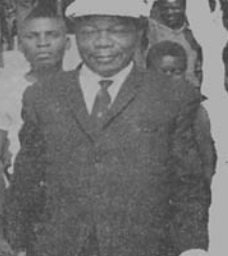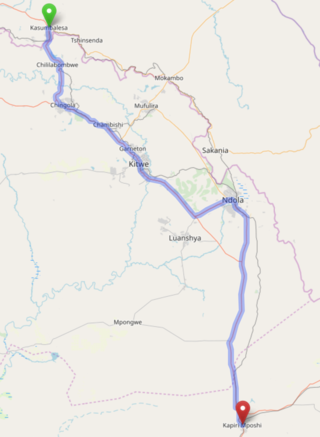Related Research Articles

Northern Rhodesia was a British protectorate in south central Africa, now the independent country of Zambia. It was formed in 1911 by amalgamating the two earlier protectorates of Barotziland-North-Western Rhodesia and North-Eastern Rhodesia. It was initially administered, as were the two earlier protectorates, by the British South Africa Company (BSAC), a chartered company, on behalf of the British Government. From 1924, it was administered by the British Government as a protectorate, under similar conditions to other British-administered protectorates, and the special provisions required when it was administered by BSAC were terminated.

Kitwe is the third largest city in terms of infrastructure development and second largest city in terms of size and population in Zambia. With a population of 517,543 Kitwe is one of the most developed commercial and industrial areas in the nation, alongside Ndola and Lusaka. It has a complex of mines on its north-western and western edges.

The Zimbabwe national rugby union team, nicknamed the Sables, represents the Zimbabwe Rugby Union in international competition. While sides representing the colony of Rhodesia have played as early as 1910, the modern day Zimbabwe rugby team did not play its first test until 1981, against Kenya. Zimbabwe has competed in two World Cups, in 1987 and 1991, in place of South Africa, who were sanctioned by the IRB at the time due to apartheid. Zimbabwe is categorized as Tier 3 Development One, which prioritizes Zimbabwe over other nations due to historical success as well as popularity of rugby in the nation.

The Copperbelt is a natural region in Central Africa which sits on the border region between northern Zambia and the southern Democratic Republic of Congo. It is known for copper mining.

Harry Mwaanga Nkumbula was a Zambian nationalist leader involved in the movement for the independence of Northern Rhodesia, as Zambia was known until the end of British rule in 1964. He was born in the village of Maala in the Namwala district of Zambia's southern province. He was the youngest of three children and the only son.

The Zambia Super League, known as the MTN Super League for sponsorship purposes, is the top association football league created in 1962 by the Football Association of Zambia. The winners of the league each season receives ZMW1,000,000 ($55,555) and a copper trophy engraved with their team name.
The history of cricket in Zimbabwe, formerly Rhodesia and before 1965 Southern Rhodesia, includes Rhodesia first forming a first-class cricket team in August 1890, and the inaugural Test appearance of Zimbabwe in October 1992.

The following outline is provided as an overview of and topical guide to Zambia:
Zambia, officially known as the Republic of Zambia, is a landlocked country in Southern Africa. The neighbouring countries are the Democratic Republic of the Congo to the north, Tanzania to the north-east, Malawi to the east, Mozambique, Zimbabwe, Botswana, and Namibia to the south, and Angola to the west. The capital city is Lusaka, located in the southeast of the country. The population is concentrated mainly around the capital and the Copperbelt to the northwest.

Rugby union in Zimbabwe is a popular sport and ranks after association football and cricket as one of the oldest and most popular sports in the country. The Zimbabwe national team, commonly known as the Sables, have been playing international rugby since the early 1900s and have made appearances in two Rugby World Cups Zimbabwe at the Rugby World Cup on two occasions. As with rugby union in Namibia, the country's lack of a professional structure, and opportunity for player's to earn an income playing rugby, has been a problem for national organisers.

Mufulira Wanderers are Zambia's most successful football club, based in the Copperbelt town of Mufulira and currently playing in the Zambia Super League for the 2023/2024 season after their promotion from the Zambia National Division One.

Established in 1950, the East Africa rugby union team is a multi-national rugby union team drawing players from Kenya, Uganda and Tanzania, though the vast majority of these came from Kenya which has traditionally been the strongest rugby playing nation in the region. The team has played against incoming international, representative and club touring sides and it conducted seven tours between 1954 and 1982.
Roan United is a Zambian football club based in Luanshya, in the Zambian Premier League and mostly successful during the early years of Zambian football. Indeed, they were the inaugural winners of the ZPL, clinching what was then called the Northern Rhodesia National Football League in 1962. They play their home matches at Kafubu Stadium.

The history of rail transport in Zambia began at the start of the twentieth century.
Elie Susman (1880-1957) was the founder of Susman Brothers, an African business partnership. He was a director of approximately 50 companies and chairman of the Rhodesian Mercantile Holding Co.
Dickson Kenneth Makwaza was a Zambian football player and coach. Nicknamed "Barbed-Wire" due to his tenacity in defence, he was one of the most decorated players in Zambian soccer history and was captain of the Zambian national team that made its first ever appearance at the African Cup of Nations tournament in Egypt in 1974. Makwaza also captained Mufulira Wanderers and was voted Zambian footballer of the year in 1973. He later coached Wanderers and several other club sides.
Chambishi is a town in Kalulushi District in the Copperbelt Province of Zambia. According to the 2021 Census its population stands at slightly above 11,000. It is located on the T3 Road between the cities of Kitwe and Chingola.

The T3 is a Trunk Road in Zambia. The road runs from Kapiri Mposhi via Ndola, Kitwe and Chingola to Kasumbalesa on the border with DR Congo. The route is a toll road from Kapiri Mposhi to just after Kitwe.
John "Ginger" Pensulo was a Zambian footballer and coach. A key player for Roan United, he led the club to the Zambian league title in its inaugural season in 1962 and was one of the men behind the team's fluid style of play, being involved in various coaching roles.
According to records from the RSSSF, there were many association football cup competitions organized in Zambia since 1962, some of which are the Independence Cup, the Zambian Challenge Cup, the Champion of Champions Cup and Zambian Coca-Cola Cup, the latter which began in 2001. These competitions are either inactive or were played no more as of 2009.
References
- Cotton, Fran (Ed.) (1984) The Book of Rugby Disasters & Bizarre Records. Compiled by Chris Rhys. London. Century Publishing. ISBN 0-7126-0911-3
- ↑ "World Rugby Year in Review 2018".
- ↑ "Men's Rankings | World Rugby".
- 1 2 IRB Zambia page Archived 11 May 2011 at the Wayback Machine retrieved 5 July 2009
- 1 2 3 Bath, Richard (ed.) The Complete Book of Rugby (Seven Oaks Ltd, 1997 ISBN 1-86200-013-1) p79
- ↑ Cotton, p107
- ↑ "George Gregan - Player Profile". Georgegregan.com. Archived from the original on 9 November 2008. Retrieved 13 November 2008.
- ↑ "Captain Courageous: Corné Krige", TheGoal.com, retrieved 26 June 2006.
- ↑ "Rugby Union World Cup Special Reports: South Africa", The Guardian , 6 October 2003.
- ↑ Cole, Rob (1 June 2009). "The British & Irish Lions : Lions from foreign lands". British & Irish Lions. Retrieved 13 June 2010.